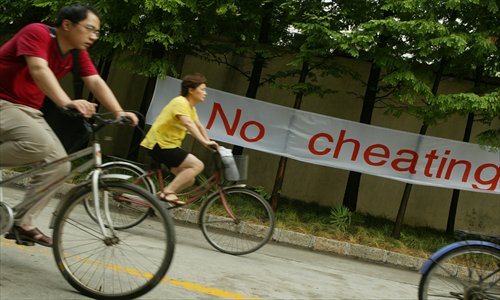The art of cheating

The entrance exams to premium art schools, often the road to stardom in the world of art and culture, have traditionally been in the national spotlight in China.
This year, however, some of the exams attracted attention for the wrong reasons. Sixteen students sitting drawing exams for the Shanghai University's art school turned out to have fake IDs. The people sitting the exams were not the actual candidates.
This was the first year that the Shanghai University used electronic detection to check fake resident identity cards in entrance exams for the art school. Security staff found 18 identity cards that did not respond properly and these were sent to a police station for verification. The police database revealed that 16 of the cards were fake.
The information on the cards, the names, ID numbers and addresses, were real, but the photos were of other people. At the end of the first exam as other students were being handed their ID cards back, the 16 "students" with the fake cards were asked to go to the supervisor's office. They all vanished quickly.
An organized scam
As all the 16 students came from Jiangsu Province, and many gave the same contact mobile phone number during registration, the university suspects that the scam might have been organized by a cram school which provided experienced practitioners to sit the students' exams for them.
The incident shone a little light on the dark side of China's exam industry. A quick search on the Internet reveals hundreds of businesses who will sit exams for you. The exams range from IELTS tests to professional exams like the exams for architect certification and prices go from 400 yuan ($64.37) to more than 20,000 yuan.
The Global Times called one of these businesses, posing as a would-be art student. The man who answered the phone said that they charged 3,000 yuan for each subject in art exams. When asked about the risks involved he said, "As long as you keep it a secret, no one will know. We're experienced in this business and you can rest assured we won't get you caught."
He said they usually asked clients to send photos to them first, and then they would find "mercenaries" who resembled the clients to sit the tests. But because it was impossible to find people who looked similar every time, they can also give these "mercenaries" fake ID cards and exam room admission cards to evade the invigilators.
Xiong Bingqi is the vice president of the 21st Century Education Research Center, and he believes that the flourishing of these businesses is the fault of the current gaokao (national college entrance exams) system. "Few of the students who apply for art colleges today actually like art. They simply regard it as an easier way to enter college. These mercenaries are needed because there are too many art students who can't draw or aren't interested in art," he said.
Lower scores
To be accepted by an art school, applicants have to pass the individual art school exams in February and March and then sit gaokao in June. However, with art school exam passes, the scores needed in the June exam are much lower. Many students regard applying for art schools as just a shortcut to the entrance to university.
Xiong estimates that 10 percent of the college candidates sit art exams, but fewer than 1 percent would be interested in art.
Sun Kaiqiang is a freshman majoring in Web design at the Shanghai campus of the China Academy of Art and he agrees. "Most of the students I know who took art exams did so to get into the college," he said.
Sun started to study painting in local cram schools during his last year in high school, after realizing that his academic performance wouldn't be good enough to get him into a good university.
"In my hometown Henan Province, the number of exam candidates is huge and the competition is fierce," the 22-year-old, from Zhumadian, said.
He sat the art exams two years in a row. "I didn't do well in the first year, so I repeated."
According to Sun, although the art schools' requirements for traditional subjects are lower, the art exams are actually tough and the competition is fierce, which is why some students hire the mercenaries.
This year, for example, 24,000 students will be competing for 800 openings at the China Central Academy of Fine Arts, a 3.3 percent admission rate. At the China Academy of Art, the admission rate is just 2 percent, with 85,000 students fighting for 1,700 places.
Students need to travel from city to city for the individual art school exams, while they also need to prepare for the June exams, which test languages and math.
It's common for art students to apply for 10 schools in the same year. Sun, for example, applied for art schools in Hangzhou, Shanghai, Beijing, Tianjin, Nanjing and Qingdao.
Uncertain and exhausted
"While I was sitting these exams, I was constantly stressed, uncertain and exhausted. I had to travel constantly, get up early in the morning and carry heavy painting equipment - easels, brushes and paints - to the exam rooms. And then there were long waits. It was a painful experience."
Sun estimated that he had spent about 100,000 yuan on traveling and education for the exams.
The Ministry of Education said this year it would raise the minimum score required to enter art colleges in 2014, and it would cancel some individual art school exams, to regulate the exams and cut down on cheating.
But Xiong said that this would not solve the problem. "As long as China's gaokao system is score-oriented, people will try to find any way possible to get an advantage. The only solution is to reform the gaokao and assess students using different approaches instead of just these standardized exams. Students shouldn't be labeled 'art students' but should be able to demonstrate their distinct talents."